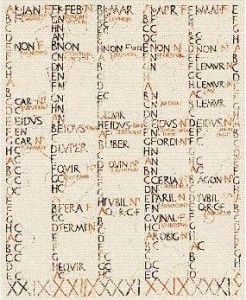 Anywhere numbers are arranged in an orderly fashion, there is predictability to the pattern. A calendar is such a collection of numbers. Unfortunately, we use one calendar for one year and change it year after year. While there should be a way to have a perpetual calendar which is not cumbersome to use, such an item does not exist. However, the smallest perpetual calendar can be made by calculation. We can find the day of the week we were born, day of the week important events in the history took place, and dates of the month a particular holiday will fall if we know the pattern of recurrence of such a holiday. The method described in this article is not new, but it is written here in an easier to understand way.
Anywhere numbers are arranged in an orderly fashion, there is predictability to the pattern. A calendar is such a collection of numbers. Unfortunately, we use one calendar for one year and change it year after year. While there should be a way to have a perpetual calendar which is not cumbersome to use, such an item does not exist. However, the smallest perpetual calendar can be made by calculation. We can find the day of the week we were born, day of the week important events in the history took place, and dates of the month a particular holiday will fall if we know the pattern of recurrence of such a holiday. The method described in this article is not new, but it is written here in an easier to understand way.
The method described in this article works only for the Gregorian calendar which is in
widespread use and for the Julian calendar which is no longer in use. This may not work for other calendars as it is not validated for them. As this method is already in place for at least decades, it is built into computations done by electronic devices. My purpose of describing the method in this article is to improve mental math of the readership as I have done in a previous article. It is for an aging generation that does not have a lot of access or ability to utilize electronic devices without undergoing formal training or undue hardships. The articles paves the way for both seniors and juniors to track down historical events to the day of the week and from there make whatever assumptions or predictions according to their own version of the meaning of that particular day of the week. In this regard, it should be mentioned that the days of the week were in fact named based on the sun and its planets.
In order to calculate the day of week for a specific date or dates of a month belonging to a
particular day of the week repeating every seven days, there are certain basic facts that have to established. There are of course seven days in a week and 12 months in a year, but the length of a year is 365?? days, less by 11 minutes. A leap year was created every four years, with some exceptions noted later, with an extra day in order to account for the extra six hours (5 hours and 49 minutes to be precise) from each year and other three years were set to have 365 days. If every month has 28 days or four weeks, calendar calculation will be a lot easier, but in order to account for 365 days in a year, there have to be some months with more than 28 days and these months should in total have 29 (365-336) extra days. April, June, September, and November have 2 additional days (30 days each) and all others, except February, have 3 additional days (31 days each). This is how the additional 29 days are fitted into a year. If year turns out to be a leap year, that one extra day is to be added to the month of February.
Given the above complexity involving the number of days in a month, any calculation involving calendars has to have a special code for each and every month. These codes are somewhat complicated but are easier to memorize than calculate which is also possible. The basic assumption is that a week is seven days long and every seven days the next week starts with day 1. To start on 1, number 7 should be considered 0. It so happens the month February has a code of 2 if the year is not a leap year, also called a common year. There is a reason for this code, but it is more complicated to understand than to remember that the second month has a code of 2. If February has code 2, the preceding month January has to have code 6 because January, unlike February, has 31 days, and to 6 one has to add the additional three days to get 9 which translates to 2 using a seven-day week as the yard-stick. If the year is a leap year, then these two codes are less by one, 5 for January and 1 for February, respectively. This change keeps the codes of other ten months unchanged even if it is a leap year.
The month of March in a common year starts with the exact same day of the week that February started because February has 28 days. The code for the month of March is therefore the same as February which is 2. In a leap year, February has 29 days and March starts a day later than the first day of February which will keep the code for March unchanged at 2 since, as mentioned above, the code for February being changed to 1. Since March has 31 days, the code for April is 2 plus 3, becomes 5, and since April has 30 days, the code for May is 0 as 7 (5+2) is also treated as zero in this calculation. If you keep working on the subsequent months of the year, you will find codes for June as 3, July 5, August 1, September 4, October 6, November 2, and December 4. Once again, when seven is reached, it is treated as zero since the next number is 1. It is
noticeable that months that have the exact same days of the week, such as September &
December and March & November, have the exact same month codes. There are many ways to remember these codes using mnemonics or some other method that makes sense for the individual. For example, one can remember January as 5 or 6 because Thai Pongal is on January either 14 or 15 and May as zero because it is the smallest word among the names of the months.
Once a few month codes are remembered, other month codes are easier to calculate.
Once you master the codes of the months, the calculation becomes almost as easy as counting numbers. There are codes for years but they are the same as the last two numbers for that year added to a code for that particular century which, as the name implies, changes every 100 years.
For year 2000 onwards, the code is zero which makes it a lot easier to use this method for this century. For the century starting in 1900, the code is 1, 1800 it is 3, 1700 it’s 5, and for 1600 it’s back to zero. These codes are based on the first day of these centuries. For example, January 1, 2000 was a Sunday and January 1, 1900 was a Monday. As discussed later in this paragraph, these are simply the seventh and first days of a week. In essence then, the calculation boils down to adding the century code, year code, month code, and the date, but there has to be an adjustment for the number of leap years that occurred since the beginning of that particular century. To this end, an additional day has to be added to each and every leap year that has passed. This is done by dividing the last two digits of the year by four and adding the number of times such a division can be done. The final equation is would then be century code plus year code plus the number of leaps plus month code plus the date. The final answer is then divided by seven to calculate the day of the week from the remainder. If the remainder is zero, it refers to the seventh day of week which has always been Sunday dating back to biblical times. Most calendars in the print format display Sunday and Saturday at the two ends of the week, but this is only for avoiding confusion. A remainder of six refers to Saturday and similarly a remainder of one refers to Monday which is easy to remember as the first day of a work week.
It is conceivable that some readers may want to do the above calculation on an electronic
calculator. When one totals the century code, year code, number of leaps, month code, and the date, then divides the total by 7, final answer will have what is called a decimal expansion. Decimal expansion means the remainder in decimals keeps expanding and repeating. As an example, dividing 1 by 7 gives an answer of 0.1428571428571 repeating and dividing 2 by 7 will start with the answer 0.2857142857142 repeating. This is a very unique situation in mathematics which one can take advantage of for this calculation. On a digital calculator the answer one gets in decimals would be a multiple of 14 (or an approximate) if the remainder is rounded to a 2-digit whole number. Using this approach, if it is 0.14, remainder is 1, 0.28 for 2, 0.42 for 3, 0.57 for 4, 0.71 for 5, and 0.85 for 6. A digital calculator, therefore, can be used for this type of calculation once this method of simplifying the remainder is understood.
I think by now a lot of readers would be thinking that there must be a more easy lazy way to do these calculations. Sure there is. Those who have internet access can find the day of the week for any day by doing a search. Then there are others who do not want or like such a method.
Thankfully, the calendar repeats every 28 years and therefore, the calendar of year 2014 is identical to that of 1986. Those who want to use this simpler method have to look for a calendar of more recent years with the year that is an exact multiple of 28. For example, if one was born in 1955, you need the calendar of 2011 to see the day of the week he/she was born. This simple method is valid only for years between 1901 and 2099, and not for those earlier or later. This is because years 1900 and 2100 are not leap years and a leap year comes only every 400 years at the dawn of centuries. This was done to account for those 11 minutes of added time mentioned earlier. This correction was not done in the Julian calendar whereas the Gregorian includes this adjustment.
Assimilating all of the above facts, this article ends with two examples of calculation of the day of week for the remembrance day in 2014 and 1986. For year 2014, one begins with zero as the century code of zero, adds 14 for 2014, then 3 for the number of leap years since the dawn of this century (dividing 14 by 3), then 2 for month of November, and 11 for the date. The total is 30 which leaves a remainder of 2 when divided by 7. Similarly, for year 1986, one begins with 1, then adds 86, then 21 for the number of leaps, 2 for November, and 11 for date. The total is 121 which when divided by 7 also leaves a remainder of 2. Mastering this skill of calendar calculation will be highly useful in many walks of life and will come handy in many situations.
By Richard Jeyaranjan, MD, PhD, FRCPC













